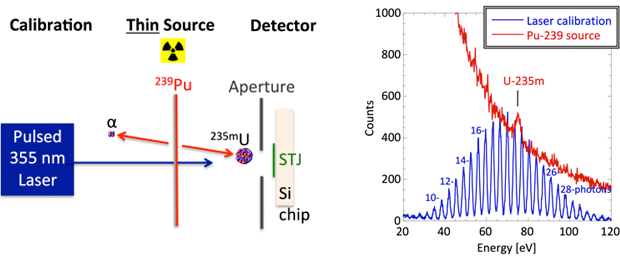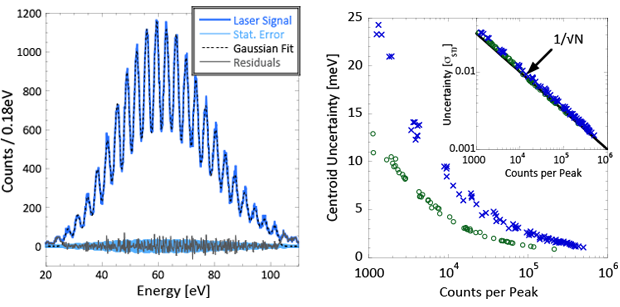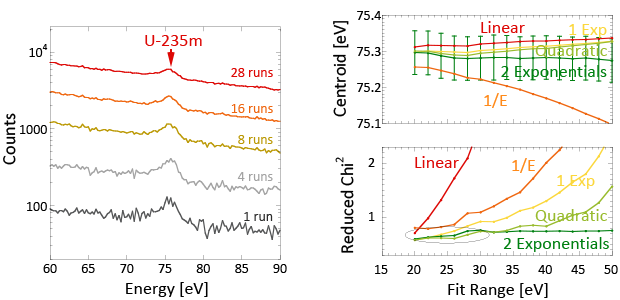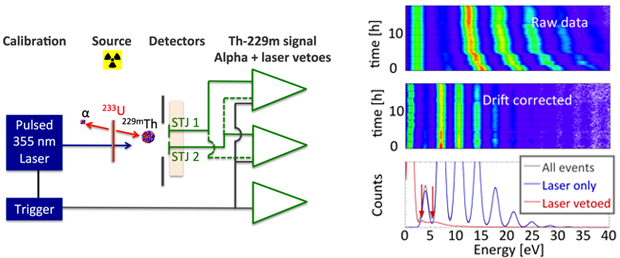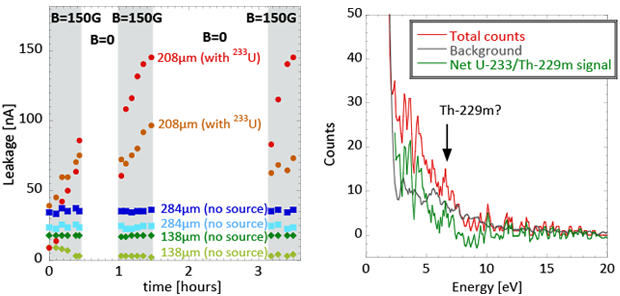Stephan Friedrich (14-LW-073)
Abstract
Our goal with this project was to use our superconducting high-resolution soft x-ray detector to unambiguously detect the emission from thorium-229m for the first time and accurately measure its energy and lifetime. As a demonstration experiment, and to quantify and reduce systematic errors of the experiment, an intermediate goal was to use the same setup to detect the decay of the world’s second-lowest-energy isomer, uranium-235m, and improve the measurement of its energy, currently known as 76.8 ± 0.5 eV. For these experiments, we added the capability to expose our superconducting detector to a pulsed ultraviolet laser calibration source. We showed that this capability could be used to calibrate the detector response with a statistics-limited accuracy of a few millielectronvolts, which is two orders of magnitude better than the uncertainty of current thorium-229m and uranium-235m measurements. We also directly detected the decay of uranium-235 and improved the accuracy of its energy by a factor of two. This demonstration experiment showed that our spectral background was too high for a direct measurement of the decay of thorium-229m. However, we made significant progress towards reducing this background. While we cannot yet claim a direct detection of the thorium-229m decay, we expect to continue working toward this experimental goal by improving the overall sensitivity. Eventually, an accurate measurement of the thorium-229m energy will allow the construction of lasers at this energy to study photo-nuclear interactions and build ultraprecise nuclear clocks.
Background and Research Objectives
Thorium-299 is known to have the lowest-energy isomer of any isotope, with the first excited nuclear state of thorium-229m only 7.6 ± 0.5 eV above the thorium-229 ground state.1 Despite intensive work for 35 years and repeated false claims of discovery, no direct emission from thorium-229m has ever been observed. Our goals were to (1) directly measure the decay of the thorium-229 isomer for the first time since its discovery, using a state-of-the-art superconducting tunnel junction to detect the decay of the isomer independent of its decay mode; (2) determine its energy with an accuracy of ±0.05 eV, improving the current value by an order of magnitude; and (3) determine its lifetime (and thus its line width). Because nuclear states are much less affected by external perturbations, an accurate measurement of the thorium-229m energy and lifetime enables the construction of ultraprecise nuclear clocks based on lasers tuned to the transition energy. Atomic clocks use a laser locked to the transition frequency between two electronic states to provide the modern standards of time and frequency. Their accuracy depends on the line width of the states and on the accuracy to which the transition frequency can be shielded from external perturbations. Transitions between nuclear states could increase the accuracy of clocks by another two to three orders of magnitude. Nuclear transitions are extremely narrow and nuclei are about 100,000x smaller than atoms and thus less susceptible to external fields.2 Such nuclear clocks would have wide applications in metrology, fundamental science, and security applications, allowing, for instance, the measurement of postulated changes in the fine structure constant over time, which is just outside the range of current frequency standards, and using nuclear transitions as qubits for quantum computing.
The existence of an ultralow level isomer in thorium-229 was first suggested in the 1970s—its energy was measured indirectly as the difference between two higher-energy gamma rays.1 Interestingly, the decay from the 7.6-eV isomer thorium-229m has never been observed directly despite almost 40 years of experimentation.3–6 This period included several claims of discovery that turned out to be premature.7–10 This is partially due to the fact that many materials (including nitrogen in the air) can produce misleading fluorescence signals of a few electronvolts when irradiated by high-energy alphas or gammas, partially because of uranium-232 contamination of the initial uranium-233 source used to produce the thorium-229 isomer, and partially because of the difficulty of detecting a low-energy signal in the presence of a high-energy background.
Our superconducting x-ray detectors have a detection threshold of about 1.5 eV and an energy resolution of around 2 eV in the energy range of interest. The background levels are below an event per minute, and thus were sufficiently low to detect emission from thorium-229m. Superconducting tunnel junctions are small thin-film devices, thus the background was expected to be low while the detection efficiency for 7.6-eV photons and recoil nuclei is near 100%. If the detector itself is used to capture thorium-229m nuclei, it can detect the full energy of the decay no matter what the decay mechanism. This is a primary advantage of our approach over that of competing groups. Our other main advantage is the availability of a very-pure uranium-233 source that produces the thorium-229m nucleus upon decay. Using this source reduced the background caused by the decay of uranium-232 that is present as an impurity in all uranium-233 sources and whose specific activity is about 2,300x higher. However, the thorium-229m nucleus of interest is created in only about 2% of all of uranium-233 decays. Thus, an intermediate goal was to use the same experimental approach to measure the decay of uranium-235m into the uranium-235 ground state. The uranium-235m isomer has a higher energy of 76.8 ± 0.5 eV and is created in all decays of a plutonium-239 source, and is therefore approximately 50x more intense than the decay of thorium-229m and easier to detect. The uranium-235 experiment would show the feasibility of the approach and allow quantifying and reducing the systematic uncertainties of the measurement.
Scientific Approach and Accomplishments
Our demonstration experiment produces the uranium-235m isomer from a plutonium-239 source that is sufficiently thin (~10 nm) so that the recoiling uranium-235m nucleus of the decay can escape from the source and be captured by the superconducting tunnel junction detector (see Figure 1, left). When the uranium-235m decays into its ground state while embedded in the detector, it excites free charge carriers above the superconducting band gap in proportion to the decay energy. These charge carriers produce a current signal that can be measured with high accuracy. The plutonium-239 source is electroplated onto an aluminized mylar foil, allowing the transmission of ultraviolet photons from a pulsed 355-nm laser. The detector resolution is sufficient to distinguish the absorption of individual 355-nm (3.5-eV) photons for accurate energy calibration. The intensity of the laser can be adjusted to absorb a small number of photons per pulse to accurately calibrate the detector at the energy of interest (see Figure 1, right).
To calibrate the detector response, we use a frequency-tripled pulsed neodymium-doped yttrium orthovanadate (Nd:YVO4) laser. We calibrated the laser output with an ultraviolet spectrometer relative to two very well-known ultraviolet lines from a mercury vapor lamp at 253.6521 and 365.0158 nm,11 obtaining an energy of 3.4975 ± 0.0002 eV per laser photon. This energy is about 2 meV less than the literature value for Nd:YVO4,12 a difference that the laser manufacturer claims is due to aging of the pump diode. We also confirmed that the laser wavelength does not change for different pump currents of the laser diode.12
We installed an optical fiber to the cryostat in which we operate our superconducting detector and filtered its output to prevent thermal infrared photons from heating the detector. For calibration, the laser intensity was adjusted to absorb a small number of 355-nm photons per pulse in the superconducting tunnel junction detector so that the average deposited energy matches the energy of the nuclear decay of interest. The energy resolution is around 2-eV full width at half maximum (FWHM) for typical 208- x 208-µm pixels in a superconducting tunnel junction detector, allowing individual photons to be easily distinguished (see Figure 2, left). While smaller superconducting tunnel junctions can have an energy resolution as high as 0.9 eV, we preferred the 208-µm pixels because they capture more of the radioactive signal. Small drifts in the laser intensity caused the observed signal to deviate from an exact Poisson distribution. We therefore found the best agreement when we fitted the calibration data simultaneously to a set of Gaussian functions without constraining the centroids or the amplitudes of the individual peaks. The resulting fit matched the data to within the statistical accuracy of the measurement and shows that the detector is linear in the energy range of interest (see Figure 2, left). The accuracy of the centroid is given by σ/√N, where σ = FWHM/2.355 is the root-mean-square width and N is the total number of counts in each peak. For peaks with N > 105, we can determine centroids with an accuracy of a few millielectronvolts (see Figure 2, right), although it is advantageous to capture fewer calibration photons and increase the time available to measure the nuclear decays.
Our detectors, therefore, have the energy resolution, count rate capabilities, and stability for calibration to an accuracy better than 10 meV. This is more than sufficient for the measurements on uranium-235m and thorium-229m.13
To characterize the decay of uranium-235, we installed an approximately 10-nm-thick plutonium-239 source on an aluminized mylar film at 0.1 K in front of the detector. We used a 150-µm-diameter platinum aperture to limit the amount of radiation absorbed in the silicon substrate below the detector, because substrate events can produce a low-energy background in the spectrum and obscure the signal of interest (see Figure 1, right). The detection of the uranium-235m decay proved to be nontrivial: the spectral background was high and the observed signal count rate was about 5x lower than expected. With the plutonium-239 source at a minimum distance of about 5 mm from the detector, we typically observed the decay of the uranium-235m recoil ions at a rate of only about one count per minute. We suspected that this may be because of water and residual gases freezing out on the source at 0.1 K and preventing the escape of the recoil ions. We therefore measured the number of recoil ions escaping from a thin uranium-234 test source in the same geometry at room temperature and at 4 K. Surprisingly, we observed that recoil ions escape from the source at 4 and 300 K at the exact same rate, suggesting that no ice layer forms on the source at low temperature. We also measured the uniformity of the source with a scanning electron microscope and did not find any inhomogeneity or clustering that could explain the reduced signal rate by absorption in the source. We concluded that the reduced signal rate is most likely because of a microscopic surface roughness of the source. The roughness would increase the effective source thickness that the recoil ions has to traverse on their way to the superconducting tunnel junction detector. We then decided not to focus on improving the source, but simply accept the reduced signal rate and count longer.
For improved statistics, we measured the decay of the uranium-235m isomer for a month (see Figure 3, left). After that period, the statistical uncertainty of the centroid was 32 meV, more than an order of magnitude better than the literature value. To determine the systematic uncertainty of this measurement, we estimated the contribution of the background subtraction to the uncertainty of the centroid. Because we had no model-based functional form of the background, we approximated the background successively by a linear quadratic, inverse single-exponential and double-exponential function, and determined the uranium-235m centroid for different choices of background function and fit range (see Figure 3, right). As expected, we found that for small-fit ranges of ±10 eV about the centroid, different choices of background function gave comparable numbers for the centroid. We eventually chose a double exponential to approximate the spectral background, because it provided a constant value of the centroid and a good fit to the data (χ2 < 1) for the widest-fit range. We estimated the systematic error due to this choice as ±8meV from the differences in the centroid for different background functions that fit the data (albeit over a smaller range) with χ2 < 1 (see Figure 3, right, circled data). This determination means that systematic errors from background subtraction and calibration accuracy currently limit the accuracy of our experiment to ±10 meV.
Unfortunately, we discovered that the value of the centroid depends on the setup of the calibration laser and changes for different laser pump currents and repetition rates. We eventually solved the problem by replacing our data acquisition system with another from a different company. We repeated the uranium-235m demonstration experiment, although only for a short time, so that we could focus on the more important thorium-229m measurement. Our current statistics-limited estimate for the energy of the uranium-235m decay is 76.90 ± 0.29 eV, compared to the literature value of 76.8 ± 0.5 eV.14
While the experimental setup shown in Figure 1 is appropriate to measure the decay of uranium-235m, the high spectral background (especially at low energies) prevented us from using this setup to detect the decay of thorium-229m, which is about 10x lower in energy and about 50x lower in intensity. The background was likely dominated by secondary ions produced by the 5-MeV alphas from the uranium-233 decay when the alphas impacted the material next to the detector. Our existing uranium-233 source was therefore not suitable, because it was too large and only a small fraction of the source faced the detector directly and contributed to the signal. The majority of the source did not have a direct line-of-sight to the detector and only contributed to the spectral background by bombarding the surfaces around the detector with high-energy radiation. We therefore purified additional uranium-233 and made a smaller source that can be placed closer to the detector. We then noticed that the superconducting tunnel junction detector changed its response over time when irradiated. This response made it necessary for us to calibrate the detector continuously (see Figure 4, right). To separate the calibration from the source-induced signal, we triggered the laser externally and used the timing information to veto laser signals (see Figure 4). In addition, we started to operate the detector arrays for increased sensitivity. This process had the additional advantage that neighboring pixels could be used to distinguish recoil ions from alpha impacts: the recoils were stopped in superconducting tunnel junctions, while the alphas traversed the junctions and deposited most of their energy in the silicon substrate, producing signals in several of the pixels.
We attempted to directly detect the decay of thorium-229m with this setup for several weeks. We found that we could calibrate the detectors continuously to account for the drift in their response and separate the drift from the signals induced by uranium-233/thorium-229 (see Figure 4, right). We even saw clear peaks at low energies induced by the uranium-233/thorium-229 source (see arrows at bottom in Figure 4, right). Unfortunately, these peaks are much too intense to be from the decay of thorium-229m, and are likely caused by fluorescence induced in the material surrounding the detector. These peaks occur within a few milliseconds of a uranium-233 decay and obscure any possible thorium-229m signal.
To reduce materials in the vicinity of the detector and reduce the source size (and thus the background counts) as much as possible, we deposited tiny drops of uranium-233 directly onto two of the detectors. This increased the signal and allowed us to use a different collimator in front of the detector that was a likely source of secondary ions and thus of the background. Unfortunately, under these circumstances, we found that the superconducting tunnel junction response degrades extremely quickly because of a rapid increase in leakage current. The degradation only occurred on pixels covered by the uranium-233 source and only while a magnetic field was applied (see Figure 5, left), providing strong evidence that the degradation occurred when magnetic flux was trapped in the superconducting tunnel junction after an alpha particle traversed the junction parallel to its electrodes and locally heated a significant fraction of the junction. Unfortunately, a magnetic field is needed to operate the detector to suppress the direct-current Josephson effect and Fiske mode resonances. We therefore faced the problem that placing a source close to the detector, while essential for highest count rate, also degraded the detector performance quickly.
The best data we acquired used a uranium-233 source at some distance from the detector. We compensated for the slow degradation of the detector response by repeating the experiment multiple times. We also exploited the fact that the decay of the thorium-229m isomer most likely had a life time on the order of milliseconds. Thus, we would most likely detect the decay signal several milliseconds after the recoil ion impact after the fluorescence background (Figure 4, right) had decayed. We therefore recorded the arrival time of every event and limited our search for the decay of thorium-229m to the time interval between 3 and 13 ms after a large superconducting tunnel junction signal from an ion impact (or an alpha) was detected. This further reduced the background in the low-energy region of interest. Currently, our best data show a hint of a possible signal around 7 eV (see Figure 5, right), although it is not statistically significant enough to draw any conclusions. It will therefore be necessary to repeat the experiment for several weeks (if not months) to improve the statistics. This time could be reduced if the spectral background could be further reduced and if the detector response could be stabilized, despite the alpha bombardment, to allow long data acquisition.
Impact on Mission
An accurate measurement of thorium-229m energy will allow development of ultraprecise nuclear clocks, which would enable measurements of the constancy of the fine-structure constant, or more precise quantum bits for quantum computing and associated security applications. Characterizing the decay of thorium-229 experimentally will lead to a better understanding of low-energy nuclear states and their calculated lifetimes, in support of the Laboratory’s core competency in nuclear, chemical, and isotopic science and technology, both key capabilities relevant to LLNL’s national security mission.
Conclusion
We demonstrated that our superconducting tunnel junction detectors have an energy resolution of 2-eV FWHM and are suitable for high-accuracy measurements of ultralow energy nuclear decays such as thorium-229m. Statistical errors can be as small as a few millielectronvolts, and systematic errors are on the order of approximately 10 meV. We also demonstrated that we could embed radioactive recoil ions from a nuclear decay inside the superconducting tunnel junctions and measure their subsequent decay into the ground state with high accuracy. We used that approach to improve the accuracy of the energy of the uranium-235m decay by a factor of 2 to 76.90 ± 0.29 eV, and can further increase the accuracy of this measurement with improved statistics. Our attempts to directly use superconducting tunnel junctions to measure the decay of thorium-229m produced hints of a signal, although it is much too early to claim a discovery.
The high-resolution laser spectra that we obtained in this project were important for a successful collaboration with STAR Cryoelectronics, the company that is fabricating the superconducting tunnel junction detectors used in this work. This will enable us to further advance research with superconducting tunnel junctions, and continue the search for the decay of thorium-229m. Specifically, we will pursue several approaches to solving the problem of degradation of measurements currently limited by a degradation of the superconducting tunnel junction response when exposed to alpha radiation in a magnetic field. Our successful demonstration experiments also put us in a strong position to obtain DOE Office of Science support in our pursuit of the elusive thorium-229m signal.
References
- Beck, B. R., et al., “Energy splitting of the ground-state doublet in the nucleus Th-229.” Phys. Rev. Lett. 98, 142501 (2007).
- Peik, E., and C. Tamm, “Nuclear laser spectroscopy of the 3.5 eV transition in Th-229” Europhys. Lett. 61, 181 (2003).
- Reich, C. W., and R. G. Helmer, “Energy separation of the doublet of intrinsic states at the ground state of Th-229.” Phys. Rev. Lett. 64, 271 (1990).
- Burke, D. G., et al., “Additional evidence for the proposed excited state at ≤5 eV in Th-229.” Phys. Rev. C 42, R499 (1990).
- Helmer, R. G., and C. W. Reich, “An excited state of Th-229 at 3.5 eV”, Phys. Rev. C 49, 1845 (1994).
- Browne, E., “Search for decay of the 3.5-eV level in 229Th.” Phys. Rev. C 64, 014311 (2001).
- Irwin, G. M., and K. H. Kim, “Observation of electromagnetic radiation from deexcitation of the Th-229 isomer.” Phys. Rev. Lett. 79(6), 990 (1997).
- Richardson, D. S., et al., “Ultraviolet photon emission observed in the search for the decay of the Th-229 isomer.” Phys. Rev. Lett. 80, 3206 (1998).
- Utter, S. B., et al., “Reexamination of the optical gamma ray decay in Th-229.” Phys. Rev. Lett. 82, 505 (1999).
- Shaw, R. W., et al., “Spontaneous ultraviolet emission from uranium-233/thorium-229 samples.” Phys. Rev. Lett. 82(6), 1109 (1999).
- Sansonetti, C. J., “Wavelengths of spectral lines in mercury pencil lamps.” Appl. Optics 35(1), 74 (1996).
- Delen, X., F. Balembois, and P. Georges, “Temperature dependence of the emission cross section of Nd:YVO4 around 1064 nm and consequences on laser operation.” J. Opt. Soc. Am. B 28(5), 972 (2011).
- Ponce, F., et al., Superconducting tunnel junctions for high precision EUV spectroscopy. (2015).
- Zhudov, V. I., et al., “Differential spectrum of the conversion electrons and the excitation energy of (1/2+)-uranium-235 isomer.” J. Exp. Theor. Phys. Lett. 30(8), 516 (1979).


